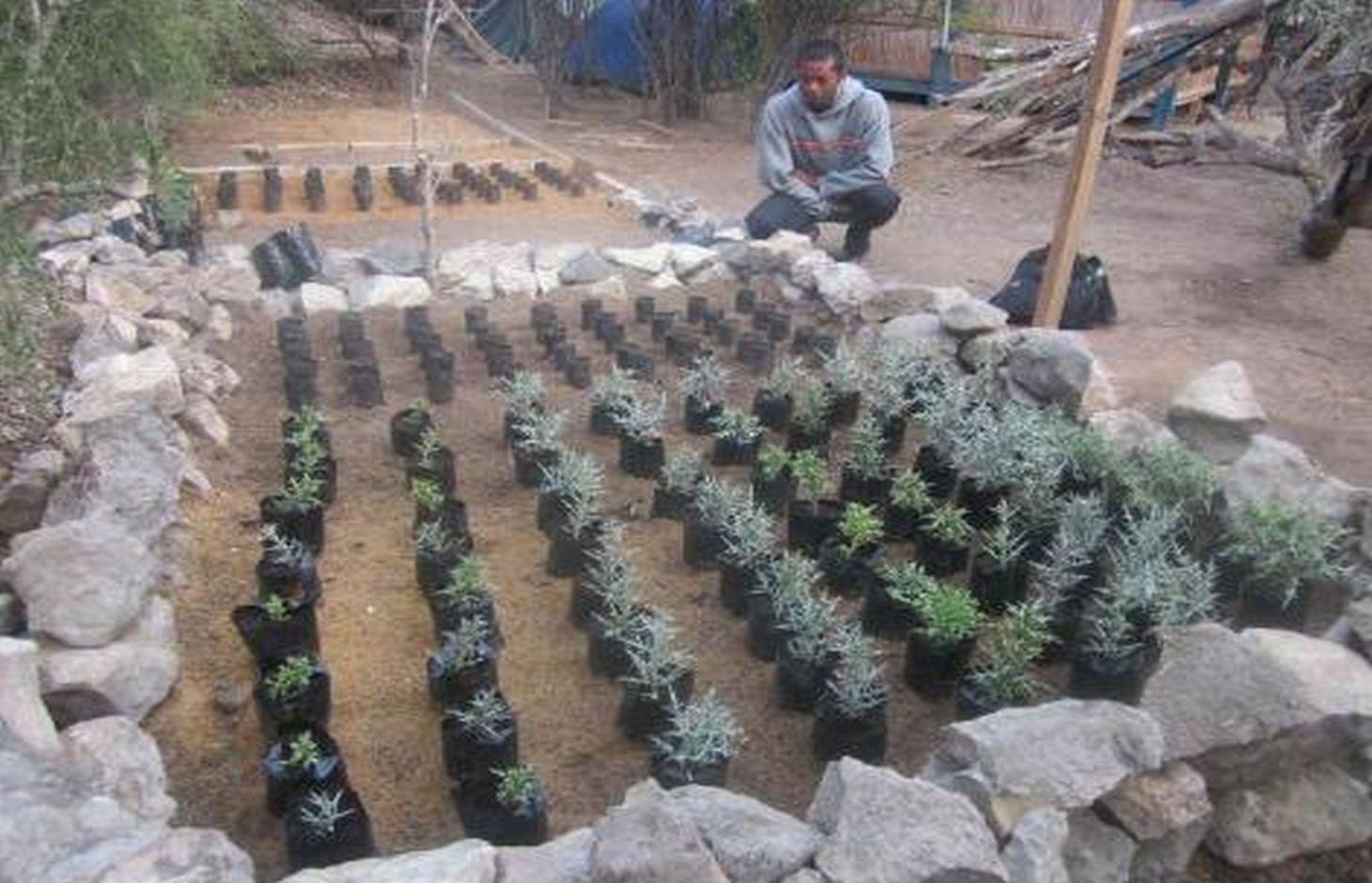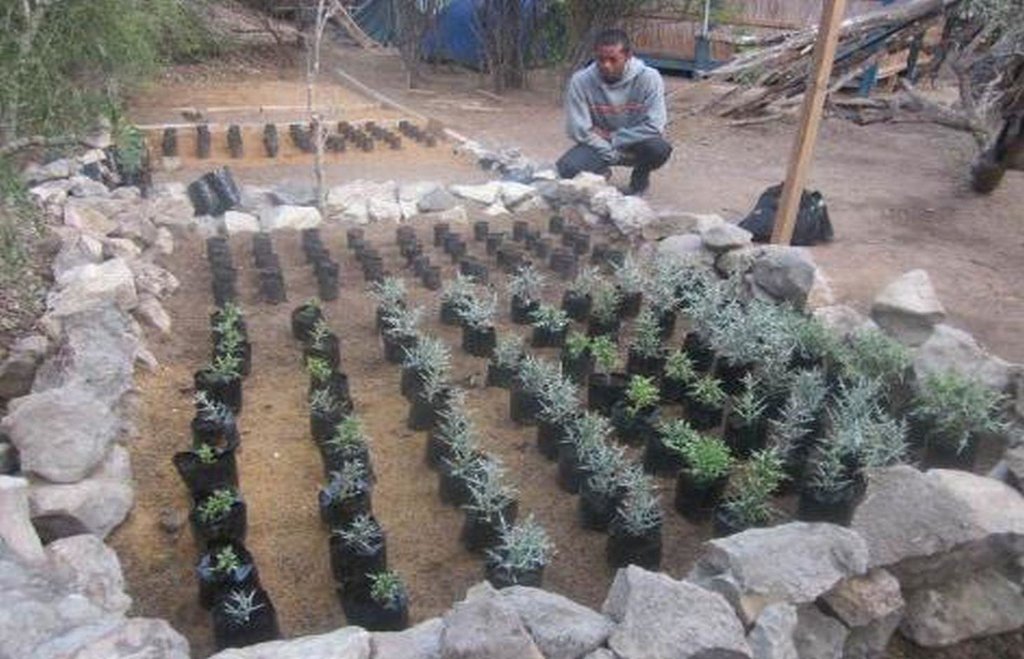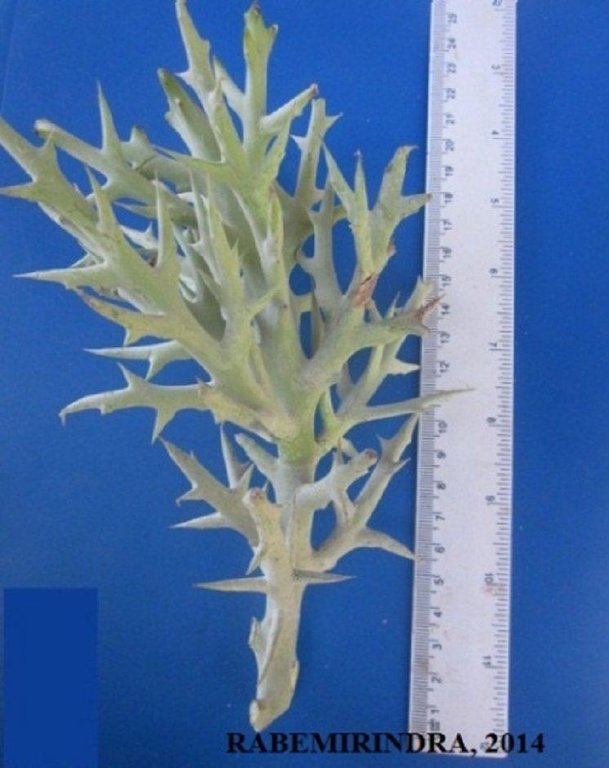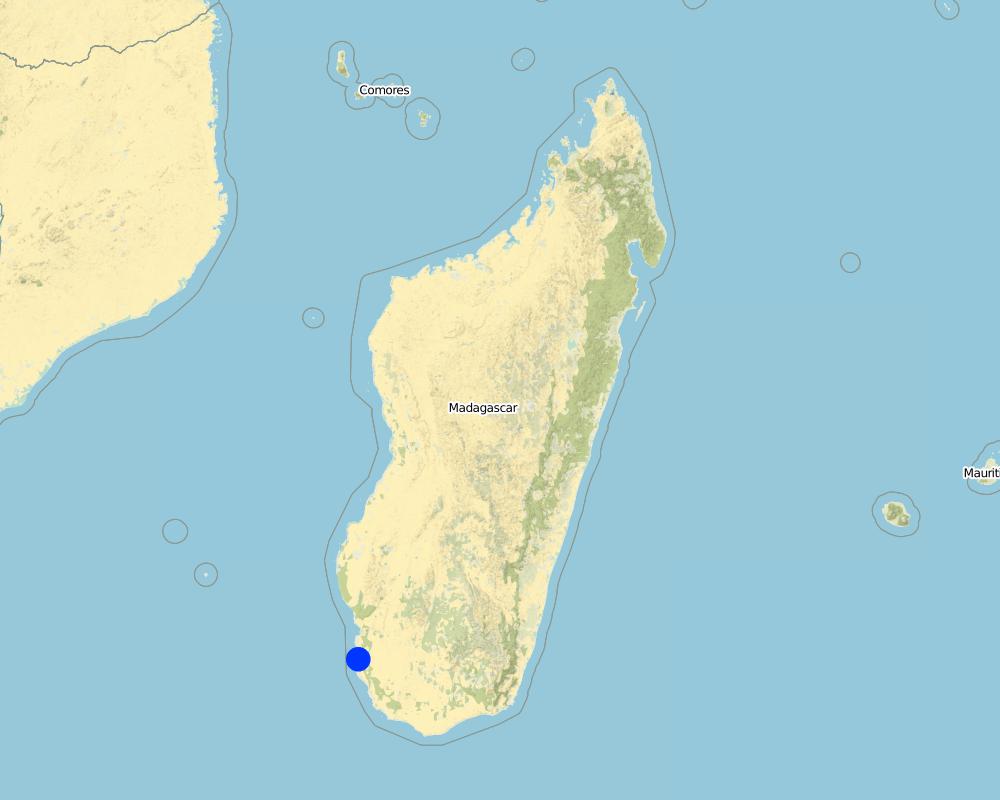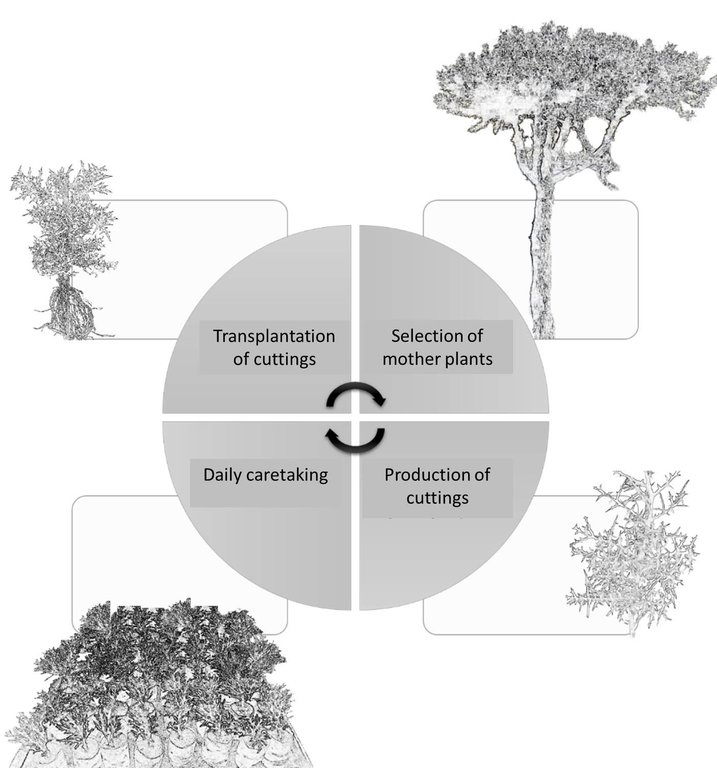Sustainable propagation of the fodder tree Euphorbia stenoclada (“samata”) [ມາດາກັສກາ]
- ການສ້າງ:
- ປັບປູງ:
- ຜູ້ສັງລວມຂໍ້ມູນ: Johanna Goetter
- ບັນນາທິການ: –
- ຜູ້ທົບທວນຄືນ: David Streiff, Fabian Ottiger, Alexandra Gavilano
technologies_1677 - ມາດາກັສກາ
- ສະຫຼຸບສັງລວມຢ່າງທັງໝົດທີ່ເປັນ PDF
- ສັງລວມເປັນບົດ PDF ເພື່ອສັ່ງພິມ
- ສັງລວມເປັນບົດ ຢູ່ໃນ browser
- ບົດສະຫຼຸບ ສະບັບເຕັມ (ບໍ່ມີແບບຟອມ)
- Sustainable propagation of the fodder tree Euphorbia stenoclada (“samata”): March 9, 2017 (inactive)
- Sustainable propagation of the fodder tree Euphorbia stenoclada (“samata”): May 3, 2017 (inactive)
- Sustainable propagation of the fodder tree Euphorbia stenoclada (“samata”): May 3, 2017 (inactive)
- Sustainable propagation of the fodder tree Euphorbia stenoclada (“samata”): Sept. 5, 2019 (public)
ເບິ່ງພາກສ່ວນ
ຂະຫຍາຍທັງໝົດ ຍຸບທັງໝົດ1. ຂໍ້ມູນທົ່ວໄປ
1.2 ຂໍ້ມູນ ການຕິດຕໍ່ພົວພັນ ຂອງບຸກຄົນທີ່ສໍາຄັນ ແລະ ສະຖາບັນ ທີ່ມີສ່ວນຮ່ວມ ໃນການປະເມີນເອກກະສານ ເຕັກໂນໂລຢີ
ຜຸ້ຊ່ຽວຊານ ດ້ານການຄຸ້ມຄອງ ທີ່ດິນແບບຍືນຍົງ:
Herinavalona Rabemirinra
University of Antananarivo
ມາດາກັສກາ
ຜຸ້ຊ່ຽວຊານ ດ້ານການຄຸ້ມຄອງ ທີ່ດິນແບບຍືນຍົງ:
Yeddiya Ratovonamana
World Wildlife Fund (WWF Toliara)
ມາດາກັສກາ
ຜຸ້ຊ່ຽວຊານ ດ້ານການຄຸ້ມຄອງ ທີ່ດິນແບບຍືນຍົງ:
Goum O. Antsonantenainarivony
University of Antananarivo
ມາດາກັສກາ
ຊື່ໂຄງການ ທີ່ອໍານວຍຄວາມສະດວກ ໃນການສ້າງເອກກະສານ/ປະເມີນ ເຕັກໂນໂລຢີ (ຖ້າກ່ຽວຂ້ອງ)
Book project: Making sense of research for sustainable land management (GLUES)ຊື່ໂຄງການ ທີ່ອໍານວຍຄວາມສະດວກ ໃນການສ້າງເອກກະສານ/ປະເມີນ ເຕັກໂນໂລຢີ (ຖ້າກ່ຽວຂ້ອງ)
Sustainable Landmanagement in south-western Madagascar (SuLaMa / GLUES)ຊື່ສະຖາບັນ (ຫຼາຍສະຖາບັນ) ທີ່ອໍານວຍຄວາມສະດວກ ໃນການສ້າງເອກກະສານ / ປະເມີນ ເຕັກໂນໂລຢີ (ຖ້າກ່ຽວຂ້ອງ)
Brandenburg Technical University (btu) - ເຢຍລະມັນຊື່ສະຖາບັນ (ຫຼາຍສະຖາບັນ) ທີ່ອໍານວຍຄວາມສະດວກ ໃນການສ້າງເອກກະສານ / ປະເມີນ ເຕັກໂນໂລຢີ (ຖ້າກ່ຽວຂ້ອງ)
University of Antananarivo - ມາດາກັສກາຊື່ສະຖາບັນ (ຫຼາຍສະຖາບັນ) ທີ່ອໍານວຍຄວາມສະດວກ ໃນການສ້າງເອກກະສານ / ປະເມີນ ເຕັກໂນໂລຢີ (ຖ້າກ່ຽວຂ້ອງ)
World Wide Fund for Nature (WWF) - ສະວິດເຊີແລນ1.3 ເງື່ອນໄຂ ກ່ຽວກັບ ການນໍາໃຊ້ຂໍ້ມູນເອກະສານ ທີ່ສ້າງຂື້ນ ໂດຍຜ່ານ ອົງການພາບລວມຂອງໂລກ ທາງດ້ານແນວທາງ ແລະ ເຕັກໂນໂລຢີ ຂອງການອານຸລັກ ທໍາມະຊາດ (WOCAT)
ຜູ້ປ້ອນຂໍ້ມູນ ແລະ ບຸກຄົນສຳຄັນ ທີ່ໃຫ້ຂໍ້ມູນ (ຫຼາຍ) ຍິນຍອມ ຕາມເງື່ອນໄຂ ໃນການນຳໃຊ້ຂໍ້ມູນ ເພື່ອສ້າງເປັນເອກກະສານຂອງ WOCAT:
ແມ່ນ
1.5 ແບບສອບຖາມທີ່ອ້າງອີງເຖີງແນວທາງ ການຄຸ້ມຄອງທີ່ດິນແບບຍືນຍົງ (ໄດ້ເຮັດເປັນເອກະສານທີ່ໃຊ້ WOCAT)
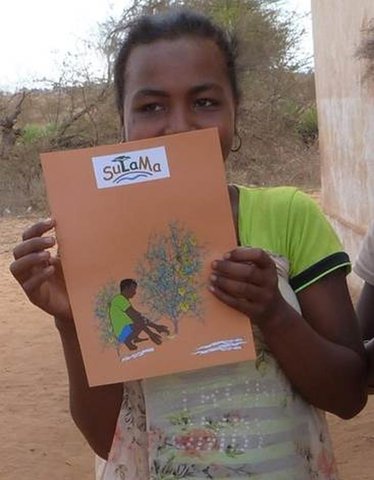
Increasing environmental awareness using comic-style illustrations as a … [ມາດາກັສກາ]
Communicating and transferring scientific results and recommendations about sustainable land management to local people
- ຜູ້ສັງລວມຂໍ້ມູນ: Tobias Feldt
2. ການອະທິບາຍ ເຕັກໂນໂລຢີ ຂອງການຄຸ້ມຄອງ ທີ່ດິນແບບຍືນຍົງ
2.1 ຄໍາອະທິບາຍສັ້ນຂອງ ເຕັກໂນໂລຢີ
ການກຳໜົດຄວາມໝາຍ ຂອງເຕັກໂນໂລຢີ:
Propagation of “samata” cuttings for long-term provision of supplementary livestock fodder to reduce the pressure on natural vegetation.
2.2 ການອະທິບາຍ ລາຍລະອຽດ ຂອງເຕັກໂນໂລຢີ
ການພັນລະນາ:
The succulent evergreen tree Euphorbia stenoclada (“samata”) is the most important dry season fodder resource on the coastal plains grazing grounds in the Mahafaly Plateau region. To increase production, samata can be vegetatively propagated with cuttings raised in a nursery. The advantages are: (a) protection against livestock, (b) selection of the most appropriate planting stock to propagate and (c) easy watering. Cuttings should only be taken from mature trees 7-10 years old and 3-4 m high. The mother plants should be healthy, with few spines, and no previous cuttings taken. Cuttings are taken at the upper nodes of the branches, approximately 20-25 cm long and 0.5-1.5 cm diameter. Transport of the cuttings to the nursery should be carried out in the morning to avoid heat. For effective rooting, the cutting is planted 5 cm (1-2 nodes) into a humid substrate in a plastic pot or directly into the ground. Best results are achieved using white sea sand mixed with some organic material. Cuttings should be raised in a sunny location. During the first 15 days, the cuttings need to be watered once every morning. For the next 3-4 months, they need watering every second morning. 24 hours before transplantation from the nursery to the final destination, the cuttings should be abundantly watered. Rooted cuttings are transplanted into pits of 10 cm diameter and 15 cm depth, filled with the same substrate as used in the nursery. For 15 days, the transplants are watered on a daily basis, and afterwards every second day. After 30-45 days, the transplants are ready to survive without further care. If the planting location is open to roaming livestock, the cuttings need protection.
Purpose of the Technology: The samata tree naturally reproduces by seeds as well as by vegetative reproduction. However the German funded SULAMA research project has had most success with multiplication of the local variety with cuttings. This form of propagation is preferable as it is much faster and gives higher survival rates of the individuals: neither does it need much planting material, equipment or technical knowledge. Providing the villagers with the know-how, and assisting them to create local samata-nurseries, makes this technology promising. SuLaMa-WWF started this technique in April 2015, establishing 5 nurseries with 2,000 trees each (3 with village communities, 2 with local schools).
Establishment / maintenance activities and inputs: On the coastal plain of the Mahafaly plateau region, the climatic and edaphic conditions do not support livestock raising based mainly on grasses. For 6-7 months, the herders are dependent on supplementary fodder plants, especially samata. The tree is fed by cutting its branches and slicing them. However pressure on this resource has led to depletion of stocks around many villages: this results from increasing demand and reduced supply. Higher demand is the result of changed herd movements, especially a shorter transhumance period. Lower supply is attributed to decreased precipitation, overuse of trees leading to poor regeneration or even the death of trees, and reduced samata areas due to the expansion of private crop fields. The overuse of trees is triggered by the overall scarcity of this resource as well as an ongoing privatization of the historically common land resources.
2.3 ຮູບພາບຂອງເຕັກໂນໂລຢີ
2.5 ປະເທດ / ເຂດ / ສະຖານທີ່ບ່ອນທີ່ ເຕັກໂນໂລຢີ ໄດ້ຮັບການນໍາໃຊ້ ແລະ ທີ່ຖືກປົກຄຸມດ້ວຍການປະເມີນຜົນ
ປະເທດ:
ມາດາກັສກາ
ພາກພື້ນ / ລັດ / ແຂວງ:
Atsimo-Andrefana, Toliara
ຂໍ້ມູນເພີ່ມເຕີມຂອງສະຖານທີ່:
Toliara II, Beheloka
ໃຫ້ລະບຸ ການແຜ່ຂະຫຍາຍ ເຕັກໂນໂລຢີ:
- ແຜ່ຂະຫຍາຍຢ່າງໄວວາໃນພື້ນທີ່
ຖ້າຫາກບໍ່ຮູ້ເນື້ອທີ່ທີ່ແນ່ນອນ, ໃຫ້ລະບຸ ເນື້ອທີ່ໂດຍປະມານ ທີ່ໃກ້ຄຽງ:
- 10-100 ກມ 2
ຄວາມຄິດເຫັນ:
Application ongoing, the envisaged implementation area might be up to 1,000 km².
Map
×2.6 ວັນທີໃນການຈັດຕັ້ງປະຕິບັດ
ຖ້າຫາກວ່າ ບໍ່ຮູ້ຈັກ ປີທີ່ຊັດເຈນ ແມ່ນໃຫ້ປະມານ ວັນທີເອົາ:
- ຕໍ່າກວ່າ 10 ປີ ຜ່ານມາ (ມາເຖິງປະຈຸບັນ)
2.7 ການນໍາສະເໜີ ເຕັກໂນໂລຢີ
ໃຫ້ລະບຸ ເຕັກໂນໂລຢີ ໄດ້ຖືກຈັດຕັ້ງປະຕິບັດຄືແນວໃດ?
- ໃນໄລຍະການທົດລອງ / ການຄົ້ນຄວ້າ
- ໂດຍຜ່ານໂຄງການ / ການຊ່ວຍເຫຼືອຈາກພາຍນອກ
ຄວາມຄິດເຫັນ (ປະເພດ ໂຄງການ ແລະ ອື່ນໆ):
Project started with experimental trials of multiplication by cuttings in February 2014, first capacity development for land users through workshops on propagation technique in May 2015.
3. ການໃຈ້ແຍກ ເຕັກໂນໂລຢີ ໃນການຄຸ້ມຄອງ ດິນແບບຍືນຍົງ
3.2 ປະເພດການນໍາໃຊ້ທີ່ດິນ ໃນປະຈຸບັນ() ທີ່ເຕັກໂນໂລຢີ ໄດ້ຖືກນໍາໃຊ້

ດິນທີ່ປູກພືດ
- ການປູກພືດປະຈໍາປີ
- ເປັນໄມ້ຢືນຕົ້ນ ແລະ ໄມ້ພຸ່ມ ຈາກການປູກພືດ
ການປູກພືດປະຈຳປີ - ລະບຸປະເພດພືດ:
- ທັນຍາພືດ-ສາລີ
- ການປູກພືດໃຫ້ຮາກ / ຫົວ-ມັນດ້າງ, ເຜືອກ. ອື່ນໆ
- ການປູກພືດໃຫ້ຮາກ / ຫົວ-ມັນຕົ້ນ
ການປູກພືດທີ່ເປັນຕົ້ນໄມ້ ແລະ ໄມ້ພຸ່ມ - ລະບຸປະເພດພືດ:
- ອາຫານສັດປະເພດເປັນຕົ້ນ ( ຄໍລຽນດຣາ, ຕົ້ນກະຖີ່ນ, ໂປຣໂສປິດ ແລະ ອື່ນໆ)
- cactus, Euphorbbia stenoclada, samata trees
ຈໍານວນ ລະດູການ ປູກໃນປີໜຶ່ງ:
- 1
ລະບຸ ຊະນິດ:
Longest growing period from month to month: June - September

ທົ່ງຫຍ້າລ້ຽງສັດ
ການລ້ຽງສັດແບບປ່ອຍ ຕາມທຳມະຊາດ:
- ການລ້ຽງສັດແບບເຄີ່ງປ່ອຍ
ທົ່ງຫຍ້າລ້ຽງສັດແບບສຸມ / ການຜະລິດອາຫານສັດ:
- ຕັດຫຍ້າ ແລະ ຂົນຫຍ້າ / ບໍ່ມີທົ່ງຫຍ້າທໍາມະຊາດ
ຄວາມຄິດເຫັນ:
Major cash crop annual cropping: Maize
Major food crop annual cropping: Cassava
Other crops annual cropping: Sweet potato
Major cash crop tree/shrub cropping: Samata (Euphorbia stenoclada)
Other crops tree/shrub cropping: Cactus
Major land use problems (compiler’s opinion): : Climatic constraints (especially low and erratic precipitation), deforestation, forest degradation, soil degradation, overgrazing, loss of arable land, fragmentation, low availability of surface and (very saline) ground water, privatization of common pool resources.
Major land use problems (land users’ perception): Climatic constraints, loss of arable land, low availability of animal fodder, soil degradation, low availability of surface and (very saline) ground water.
Semi-nomadism / pastoralism: Yes
Cut-and-carry/ zero grazing: Yes
Type of cropping system and major crops comments: samata trees are both found on the grazing area (naturally), as well as on agricultural fields (naturally, transplanted). Main reason for transplanting to fields however not shade/other positive interaction with crops, but for property rights reasons.
Livestock density: 1-10 LU /km2
3.4 ການສະໜອງນ້ຳ
ການສະໜອງນໍ້າ ໃນພື້ນທີ່ ທີ່ໄດ້ນໍາໃຊ້ ເຕັກໂນໂລຢີ:
- ນໍ້າຝົນ
3.5 ການນໍາໃຊ້ເຕັກໂນໂລຢີ ທີ່ຢູ່ໃນກຸ່ມການຄຸ້ມຄອງ ທີ່ດິນແບບຍືນຍົງ
- ການປັບປຸງແນວພັນພືດ / ແນວພັນສັດ
- Propagation of fodder plants
3.6 ມາດຕະການ ການຄຸ້ມຄອງ ທີ່ດິນແບບຍືນຍົງ ປະກອບດ້ວຍ ເຕັກໂນໂລຢີ

ມາດຕະການ ທາງດ້ານພືດພັນ
- V1: ເປັນໄມ້ຢືນຕົ້ນ ແລະ ການປົກຫຸ້ມຂອງໄມ້ພຸ່ມ
ຄວາມຄິດເຫັນ:
Main measures: vegetative measures
Type of vegetative measures: in blocks
3.7 ປະເພດດິນເຊື່ອມໂຊມ ຫຼັກທີ່ໄດ້ນໍາໃຊ້ ເຕັກໂນໂລຢີ

ການເຊື່ອມໂຊມ ທາງຊີວະພາບ
- Bc: ການຫຼຸດຜ່ອນການປົກຫຸ້ມຂອງພືດ
- Bh: ການສູນເສຍ ທີ່ຢູ່ອາໃສ ຂອງສິ່ງທີ່ມີຊິວິດ
- Bq: ປະລິມານ / ອິນຊີວັດຖຸຫຼຸດລົງ
ຄວາມຄິດເຫັນ:
Main type of degradation addressed: Bc: reduction of vegetation cover, Bq: quantity / biomass decline
Secondary types of degradation addressed: Bh: loss of habitats
Main causes of degradation: deforestation / removal of natural vegetation (incl. forest fires) (Slash&burn, charcoal production, overgrazing and grazing in forests), overgrazing (overexploitation of samata-trees), change of seasonal rainfall, droughts, other natural causes (avalanches, volcanic eruptions, mud flows, highly susceptible natural resources, extreme topography, etc.) specify (cyclones), population pressure (ca. 3% / year), poverty / wealth (Extreme poverty, subsistence and low economic development), education, access to knowledge and support services (limited access to improved tecniques for agriculture and livestock keeping)
Secondary causes of degradation: crop management (annual, perennial, tree/shrub) (Non-optimized crops), over-exploitation of vegetation for domestic use (Overexploitation of wild plants), Heavy / extreme rainfall (intensity/amounts), wind storms / dust storms, land tenure (privatization of formerly open access rangeland leading to increased pressure on still open access samata-trees), inputs and infrastructure: (roads, markets, distribution of water points, other, …), war and conflicts (armed cattle rustling on neighboring plateau let to new transhumance pattern towards implementation region, thus higher pressure on fodder resources), governance / institutional (limited access to improved tecniques for agriculture and livestock keeping)
3.8 ການປ້ອງກັນ, ການຫຼຸດຜ່ອນ, ຫຼືການຟື້ນຟູຂອງການເຊື່ອມໂຊມຂອງດິນ
ຄວາມຄິດເຫັນ:
Main goals: mitigation / reduction of land degradation, rehabilitation / reclamation of denuded land
Secondary goals: prevention of land degradation
4. ຂໍ້ກໍາໜົດ, ກິດຈະກໍາການປະຕິບັດ, ວັດຖຸດິບ, ແລະຄ່າໃຊ້ຈ່າຍ
4.1 ເຕັກນິກ ໃນການແຕ້ມແຜນວາດ ເຕັກໂນໂລຢີ
ຄຸນລັກສະນະ ຂອງເຕັກນິກ (ທີ່ກ່ຽວຂ້ອງ ກັບການແຕ້ມແຜນວາດ ທາງດ້ານເຕັກນີກ):
Multiplication of samata trees through cuttings preferably in the cold season from June to August: (1) Selection of suitable mother plants: adult trees 7-10 years old, 3-4 m high, good phytosanitary condition, low in spines, without previous cuttings taken (2) Taking cuttings with a sharp knife at the upper nodes of the branches, approximately 20-25 cm long and 0.5-1.5 cm in diameter. To ensure the survival of the mother tree, at least 10 branches should remain uncut. Transportation of the cuttings to the nursery takes place preferably in the early morning to avoid heat. (3) Daily care of cuttings in nurseries till the roots are well-established. The cuttings are planted 5 cm deep (1-2 nodes) into a humid substrate in a plastic bag or pot, filled with a substrate of white ocean sand mixed with some organic material, for example dung (75% sand, 25% dung). During the first 15 days, the cuttings need to be watered once every morning. For the next 3-4 months, they need watering every second morning. Shade has to be avoided. (4) Transplanting cuttings: 24 hours before transplanting, the cuttings need to be abundantly watered. The rooted cuttings are transplanted into holes of 10 cm diameter and 15 cm depth, filled with the same substrate used in
the nursery. For 15 days, the transplants are watered on a daily basis, and afterwards every second day. After 30-45 days, the transplants will be ready to survive without any further human attention.
Technical knowledge required for field staff / advisors: low
Technical knowledge required for land users: low
Main technical functions: increase of biomass (quantity)
Aligned: -contour
Vegetative material: T : trees / shrubs
In blocks
Vegetative material: T : trees / shrubs
Number of plants per (ha): 300
Spacing between rows / strips / blocks (m): 5
Vertical interval within rows / strips / blocks (m): 5
Width within rows / strips / blocks (m): 0.3
Trees/ shrubs species: Euphorbbia stenoclada, planted cuttings (artificial vegetative multiplication)
Slope (which determines the spacing indicated above): 0%
Gradient along the rows / strips: 0%
ຜູ້ຂຽນ:
RATOVONAMANA R. Yeddiya, UNIVERSITE D’ANTANANARIVO FACULTE DES SCIENCES DEPARTEMENT DE BIOLOGIE ET ECOLOGIE VEGETALES
4.2 ຂໍ້ມູນທົ່ວໄປກ່ຽວກັບການຄິດໄລ່ປັດໃຈຂາເຂົ້າໃນການຜະລິດ ແລະ ມູນຄ່າອື່ນໆ
ສະກຸນເງິນອື່ນໆ / ປະເທດອື່ນໆ (ລະບຸ):
Madagascar-Ariary
ຖ້າກ່ຽວຂ້ອງ, ໃຫ້ລະບຸອັດຕາແລກປ່ຽນຈາກ USD ເປັນສະກຸນເງິນທ້ອງຖິ່ນ (ເຊັ່ນ: 1 USD = 79.9 Brazilian Real): 1 USD =:
3227.0
ລະບຸ ຄ່າຈ້າງ ຄ່າແຮງງານສະເລ່ຍ ຕໍ່ ວັນ:
1.55
4.3 ການສ້າງຕັ້ງກິດຈະກໍາ
| ກິດຈະກໍາ | Timing (season) | |
|---|---|---|
| 1. | Collection of cuttings from mother trees | End of wet season |
| 2. | Preparation of substrate and pots/bags | End of wet season |
| 3. | Planting of cuttings in plastic pots/bags | End of wet season |
| 4. | Watering of cuttings during the dry season | First every day, after 15 days every second day during dry season, till transplantion to final destination |
| 5. | Fencing of final destination area for cuttings (hedges of local material), if neccesary | Before transplantation of cuttings |
| 6. | Transplantation of cuttings from plastic pots to final destination | During next wet season |
| 7. | Monitoring | first days after transplantation |
| 8. | Watering of small trees | Every day for first 15 days, then every second day (30-45 days after transplantation) |
4.4 ຕົ້ນທຶນ ແລະ ປັດໄຈຂາເຂົ້າທີ່ຈໍາເປັນໃນຈັດຕັ້ງປະຕິບັດ
| ລະບຸ ປັດໃຈ ນໍາເຂົ້າ ໃນການຜະລີດ | ຫົວໜ່ວຍ | ປະລິມານ | ຕົ້ນທຶນ ຕໍ່ຫົວໜ່ວຍ | ຕົ້ນທຶນທັງໝົດ ຂອງປັດໃຈຂາເຂົ້າ ໃນການຜະລິດ | % ຂອງຕົ້ນທຶນທັງໝົດ ທີ່ຜູ້ນໍາໃຊ້ທີ່ດິນ ໃຊ້ຈ່າຍເອງ | |
|---|---|---|---|---|---|---|
| ແຮງງານ | Labour | ha | 1.0 | 415.0 | 415.0 | 100.0 |
| ອຸປະກອນ | Tools | ha | 1.0 | 23.0 | 23.0 | 100.0 |
| ວັດສະດຸໃນການປູກ | Earth and manure | ha | 1.0 | 7.5 | 7.5 | 100.0 |
| ອື່ນໆ | Transportation, ox chart hire | ha | 1.0 | 9.3 | 9.3 | 100.0 |
| ອື່ນໆ | Plastic pots | ha | 1.0 | 93.0 | 93.0 | 100.0 |
| ຕົ້ນທຶນທັງໝົດ ໃນການຈັດຕັ້ງປະຕິບັດ ເຕັກໂນໂລຢີ | 547.8 | |||||
| ຄ່າໃຊ້ຈ່າຍທັງໝົດ ສຳລັບການສ້າງຕັ້ງເຕັກໂນໂລຢີ ເປັນສະກຸນເງີນໂດລາ | 0.17 | |||||
ຄວາມຄິດເຫັນ:
Duration of establishment phase: 4.5 month(s)
4.6 ຄ່າໃຊ້ຈ່າຍ ແລະ ປັດໄຈນໍາເຂົ້າທີ່ຈໍາເປັນສໍາລັບການບໍາລຸງຮັກສາກິດຈະກໍາ / ແຜນປະຕິບັດ (ຕໍ່ປີ)
ຄວາມຄິດເຫັນ:
Machinery/ tools: knives, scissors, shovels, watering cans
4.7 ປັດໄຈ ທີ່ສໍາຄັນ ທີ່ສົ່ງຜົນກະທົບ ຕໍ່ຄ່າໃຊ້ຈ່າຍ
ໃຫ້ອະທິບາຍ ປັດໃຈ ທີ່ສົ່ງຜົນກະທົບ ຕໍ່ຕົ້ນທຶນ ໃນການຈັດຕັ້ງປະຕິບັດ:
The multiplication of samata trees comprise labour costs mainly. The time spent watering the cuttings is the most significant.
There are no maintenance costs, as after transplantation to final destination and watering for some month, there are no yearly recurring activities.
5. ສະພາບແວດລ້ອມທໍາມະຊາດ ແລະ ມະນຸດ
5.1 ອາກາດ
ປະລິມານນໍ້າຝົນປະຈໍາປີ
- < 250 ມີລິແມັດ
- 251-500 ມີລິແມັດ
- 501-750 ມີລິແມັດ
- 751-1,000 ມີລິແມັດ
- 1,001-1,500 ມີລິແມັດ
- 1,501-2,000 ມີລິແມັດ
- 2,001-3,000 ມີລິແມັດ
- 3,001-4,000 ມີລິແມັດ
- > 4,000 ມີລິແມັດ
ເຂດສະພາບອາກາດກະສິກໍາ
- ເຄິ່ງແຫ້ງແລ້ງ
Thermal climate class: tropics
Thermal climate class: subtropics
5.2 ພູມິປະເທດ
ຄ່າສະເລ່ຍ ຄວາມຄ້ອຍຊັນ:
- ພື້ນທີ່ຮາບພຽງ (0-2%)
- ອ່ອນ (3-5 %)
- ປານກາງ (6-10 %)
- ມ້ວນ (11-15 %)
- ເນີນ(16-30%)
- ໍຊັນ (31-60%)
- ຊັນຫຼາຍ (>60%)
ຮູບແບບຂອງດິນ:
- ພູພຽງ / ທົ່ງພຽງ
- ສັນພູ
- ເປີ້ນພູ
- ເນີນພູ
- ຕີນພູ
- ຮ່ອມພູ
ເຂດລະດັບສູງ:
- 0-100 ແມັດ a.s.l.
- 101-500 ແມັດ a.s.l.
- 501-1,000 ແມັດ a.s.l.
- 1,001-1,500 ແມັດ a.s.l.
- 1,501-2,000 ແມັດ a.s.l.
- 2,001-2,500 ແມັດ a.s.l.
- 2,501-3,000 ແມັດ a.s.l.
- 3,001-4,000 ແມັດ a.s.l.
- > 4,000 ແມັດ a.s.l.
5.3 ດິນ
ຄວາມເລິກ ຂອງດິນສະເລ່ຍ:
- ຕື້ນຫຼາຍ (0-20 ຊັງຕີແມັດ)
- ຕື້ນ (21-50 ຊຕມ)
- ເລີກປານກາງ (51-80 ຊຕມ)
- ເລິກ (81-120 ຊມ)
- ເລິກຫຼາຍ (> 120 cm)
ເນື້ອດິນ (ໜ້າດິນ):
- ຫຍາບ / ເບົາ (ດິນຊາຍ)
ຊັ້ນອິນຊີວັດຖຸ ເທິງໜ້າດິນ:
- ຕໍາ່ (<1 %)
ຖ້າເປັນໄປໄດ້ ແມ່ນໃຫ້ຕິດຄັດ ການພັນລະນາດິນ ຫຼື ຂໍ້ມູນສະເພາະຂອງດິນ, ຕົວຢ່າງ, ຄຸນລັກສະນະ ປະເພດຂອງດິນ, ຄ່າຄວາມເປັນກົດ / ເປັນດ່າງຂອງດິນ, ສານອາຫານ, ດິນເຄັມ ແລະ ອື່ນໆ.
Soil fertility is very low
Soil drainage/infiltration is good
Soil water storage capacity is very low
5.4 ມີນໍ້າ ແລະ ຄຸນນະພາບ
ລະດັບ ນໍ້າໃຕ້ດິນ:
5-50 ແມັດ
ການມີນໍ້າ ເທິງໜ້າດິນ:
ທຸກຍາກ / ບໍ່ມີ
ຄຸນນະພາບນໍ້າ (ບໍ່ມີການບໍາບັດ):
ບໍ່ມີນໍ້າດື່ມ (ຮຽກຮ້ອງໃຫ້ມີການບຳບັດນ້ຳ)
5.5 ຊີວະນາໆພັນ
ຄວາມຫຼາກຫຼາຍ ທາງສາຍພັນ:
- ປານກາງ
5.6 ຄຸນລັກສະນະ ຂອງຜູ້ນໍາໃຊ້ທີ່ດິນ ທີ່ໄດ້ນໍາໃຊ້ເຕັກໂນໂລຢີ
ລະບົບ ການຕະຫຼາດ ແລະ ຜົນຜະລິດ:
- ກຸ້ມຕົນເອງ (ພໍພຽງ)
- ປະສົມປົນເປ( ກຸ້ມຕົນເອງ/ເປັນສິນຄ້າ)
ລາຍຮັບ ທີ່ບໍ່ໄດ້ມາຈາກ ການຜະລິດ ກະສິກໍາ:
- ໜ້ອຍກ່ວາ 10 % ຂອງລາຍຮັບທັງໝົດ
ລະດັບຄວາມຮັ່ງມີ:
- ທຸກຍາກຫຼາຍ
- ທຸກຍາກ
ບຸກຄົນ ຫຼື ກຸ່ມ:
- ບຸກຄົນ / ຄົວເຮືອນ
ລະດັບ ການຫັນເປັນກົນຈັກ:
- ການໃຊ້ແຮງງານຄົນ
ເພດ:
- ຜູ້ຍິງ
- ຜູ້ຊາຍ
ໃຫ້ລະບຸ ຄຸນລັກສະນະ ຂອງຜູ້ນໍາໃຊ້ທີ່ດິນ:
Land users applying the Technology are mainly common / average land users
Population density: 10-50 persons/km2
Annual population growth: 3% - 4%
1% of the land users are rich.
9% of the land users are average wealthy.
20% of the land users are poor.
70% of the land users are poor.
Off-farm income specification: business, trade, temporary labour migration, charcoal making
Market orientation cropland production system: Subistence (self-supply) (agriculture with annual food shortages and some off-farm income) and mixed (subsistence and commercial) (livestock mainly used for selling and thus getting some cash in order to buy food or other aims)
Market orientation grazing land production system: Mixed (subsistence and commercial) (samata has become an importan local cash crop, selling of annual harvesting rights to livestock owners )
5.7 ເນື້ອທີ່ສະເລ່ຍຂອງດິນ ທີ່ຜູ້ນຳໃຊ້ທີ່ດິນ ໃຊ້ເຮັດເຕັກໂນໂລຢີ
- <0.5 ເຮັກຕາ
- 0.5-1 ເຮັກຕາ
- 1-2 ເຮັກຕາ
- 2-5 ເຮັກຕາ
- 5-15 ເຮັກຕາ
- 15-50 ເຮັກຕາ
- 50-100 ເຮັກຕາ
- 100-500 ເຮັກຕາ
- 500-1,000 ເຮັກຕາ
- 1,000-10,000 ເຮັກຕາ
- > 10,000 ເຮັກຕາ
ຖືໄດ້ວ່າ ເປັນຂະໜາດນ້ອຍ, ກາງ ຫຼື ໃຫຍ່ (ອີງຕາມເງື່ອນໄຂ ສະພາບຄວາມເປັນຈິງ ຂອງທ້ອງຖີ່ນ)? :
- ຂະໜາດນ້ອຍ
5.8 ເຈົ້າຂອງທີ່ດິນ, ສິດໃຊ້ທີ່ດິນ, ແລະ ສິດທິການນໍາໃຊ້ນໍ້າ
ເຈົ້າຂອງດິນ:
- ລັດ
ສິດທິ ໃນການນໍາໃຊ້ທີ່ດິນ:
- ບຸກຄົນ
ສິດທິ ໃນການນໍາໃຊ້ນໍ້າ:
- ເປີດກວ້າງ (ບໍ່ມີການຈັດຕັ້ງ)
ຄວາມຄິດເຫັນ:
Land devoted by the communities for crop production belong to clans/lineages and their members (individual, untitled), while land devoted to grazing is an open access common pool resource, but currently undergoing an unregulated privatization process.
5.9 ການເຂົ້າເຖິງການບໍລິການ ແລະ ພື້ນຖານໂຄງລ່າງ
ສຸຂະພາບ:
- ທຸກຍາກ
- ປານກາງ
- ດີ
ການສຶກສາ:
- ທຸກຍາກ
- ປານກາງ
- ດີ
ການຊ່ວຍເຫຼືອ ດ້ານວິຊາການ:
- ທຸກຍາກ
- ປານກາງ
- ດີ
ການຈ້າງງານ (ຕົວຢ່າງ, ການເຮັດກິດຈະກໍາອື່ນ ທີ່ບໍ່ແມ່ນ ການຜະລິດກະສິກໍາ):
- ທຸກຍາກ
- ປານກາງ
- ດີ
ຕະຫຼາດ:
- ທຸກຍາກ
- ປານກາງ
- ດີ
ພະລັງງານ:
- ທຸກຍາກ
- ປານກາງ
- ດີ
ຖະໜົນຫົນທາງ ແລະ ການຂົນສົ່ງ:
- ທຸກຍາກ
- ປານກາງ
- ດີ
ການດື່ມນໍ້າ ແລະ ສຸຂາພິບານ:
- ທຸກຍາກ
- ປານກາງ
- ດີ
ການບໍລິການ ທາງດ້ານການເງິນ:
- ທຸກຍາກ
- ປານກາງ
- ດີ
6. ຜົນກະທົບ ແລະ ລາຍງານສະຫຼຸບ
6.1 ການສະແດງຜົນກະທົບ ພາຍໃນພື້ນທີ່ ທີ່ໄດ້ຈັດຕັ້ງປະຕິບັດ ເຕັກໂນໂລຢີ
ຜົນກະທົບທາງເສດຖະກິດສັງຄົມ
ການຜະລິດ
ການຜະລິດອາຫານສັດ
ຄຸນນະພາບຂອງອາຫານສັດ
ຜົນຜະລິດຂອງສັດ
ຜົນຜະລິດໄມ້
ລາຍໄດ້ ແລະ ຄ່າໃຊ້ຈ່າຍ
ລາຍຮັບ ຈາກການຜະລີດ
ມີວຽກໜັກ
ຜົນກະທົບດ້ານວັດທະນາທໍາສັງຄົມ
ການຄໍ້າປະກັນ ສະບຽງອາຫານ / ກຸ້ມຢູ່ກຸ້ມກິນ
ຄວາມຄິດເຫັນ / ລະບຸແຈ້ງ:
more/better fodder --> less loss in animals --> easier to mitigate annual food shortage (subsistance agriculture) by selling animals
ການຫຼຸດຜ່ອນ ຂໍ້ຂັດແຍ່ງ
Improved livelihoods and human well-being
ຄວາມຄິດເຫັນ / ລະບຸແຈ້ງ:
Still not, as technology still very new, knowledge transfer has just started very recently (May 2015).
ຜົນກະທົບຕໍ່ລະບົບນິເວດ
ຊີວະນານາພັນ: ສັດ, ພືດ
ມວນຊີວະພາບ / ຢູ່ເທິງຊັ້ນດິນ C
ຊະນິດທີ່ເປັນປະໂຫຍດ
ຜົນກະທົບຕໍ່ລະບົບນິເວດອື່ນໆ
Shade for wild and domestic animals
Pressure on / degradation of wild samata
6.3 ການປ້ອງກັນ ແລະ ຄວາມບອບບາງ ຂອງເຕັກໂນໂລຢິ ໃນການປ່ຽນແປງສະພາບດິນຟ້າອາກາດ ແລະ ກ່ຽວຂ້ອງກັບອາກາດທີ່ມີການປ່ຽນແປງທີ່ຮຸນແຮງ / ໄພພິບັດທາງທໍາມະຊາດ (ຮັບຮູ້ໄດ້ໂດຍຜູ້ນໍາໃຊ້ທີ່ດິນ)
ການປ່ຽນແປງດິນຟ້າອາກາດ ເທື່ອລະກ້າວ
ການປ່ຽນແປງດິນຟ້າອາກາດ ເທື່ອລະກ້າວ
| ລະດູການ | ເພີ່ມຂື້ນ ຫຼື ຫຼຸດລົງ | ການນໍາໃຊ້ ເຕັກໂນໂລຢີ ສາມາດ ຮັບມື ໄດ້ຄືແນວໃດ? | |
|---|---|---|---|
| ອຸນຫະພູມປະຈໍາປີ | ເພີ່ມຂື້ນ | ບໍ່ຮູ້ |
ອາກາດ ທີ່ກ່ຽວພັນກັບຄວາມຮຸນແຮງ (ໄພພິບັດທາງທໍາມະຊາດ)
ໄພພິບັດທາງອຸຕຸນິຍົມ
| ການນໍາໃຊ້ ເຕັກໂນໂລຢີ ສາມາດ ຮັບມື ໄດ້ຄືແນວໃດ? | |
|---|---|
| ພະຍຸຝົນ | ບໍ່ຮູ້ |
| ພາຍຸລົມທ້ອງຖິ່ນ | ບໍ່ດີ |
ໄພພິບັດທາງພູມອາກາດ
| ການນໍາໃຊ້ ເຕັກໂນໂລຢີ ສາມາດ ຮັບມື ໄດ້ຄືແນວໃດ? | |
|---|---|
| ແຫ້ງແລ້ງ | ບໍ່ດີ |
ໄພພິບັດທາງອຸທົກກະສາກ
| ການນໍາໃຊ້ ເຕັກໂນໂລຢີ ສາມາດ ຮັບມື ໄດ້ຄືແນວໃດ? | |
|---|---|
| ໂດຍທົ່ວໄປ (ແມ່ນໍ້າ) ນໍ້າຖ້ວມ | ບໍ່ຮູ້ |
ຜົນສະທ້ອນສະພາບອາກາດອື່ນໆທີ່ກ່ຽວຂ້ອງ
ຜົນສະທ້ອນສະພາບອາກາດອື່ນໆທີ່ກ່ຽວຂ້ອງ
| ການນໍາໃຊ້ ເຕັກໂນໂລຢີ ສາມາດ ຮັບມື ໄດ້ຄືແນວໃດ? | |
|---|---|
| ໄລຍະເວລາການຂະຫຍາຍຕົວຫຼຸດລົງ | ບໍ່ຮູ້ |
6.4 ການວິເຄາະຕົ້ນທຶນ ແລະ ຜົນປະໂຫຍດ
ຈະເຮັດປະໂຫຍດເພື່ອປຽບທຽບກັບຄ່າໃຊ້ຈ່າຍກັບສິ່ງກໍ່ສ້າງ (ຈາກທັດສະນະຂອງຜູ້ນຳໃຊ້ທີ່ດິນ) ໄດ້ແນວໃດ?
ຜົນຕອບແທນ ໃນໄລຍະສັ້ນ:
ຜົນກະທົບທາງລົບເລັກນ້ອຍ
ຜົນຕອບແທນ ໃນໄລຍະຍາວ:
ຜົນກະທົບທາງບວກຫຼາຍ
6.5 ການປັບຕົວຮັບເອົາເຕັກໂນໂລຢີ
ຄວາມຄິດເຫັນ:
Comments on acceptance with external material support: Knowledge transfer of new technology has just started recently
Comments on spontaneous adoption: Knowledge transfer of new technology has just started recently
There is no trend towards spontaneous adoption of the Technology
Comments on adoption trend: Knowledge transfer of new technology has just started recently
6.7 ຈຸດແຂງ / ຂໍ້ດີ / ໂອກາດ ໃນການນໍາໃຊ້ ເຕັກໂນໂລຢີ
| ຈຸດແຂງ / ຈຸດດີ / ໂອກາດ ຈາກທັດສະນະຂອງຜູ້ປ້ອນຂໍ້ມູນ ຫຼື ບຸກຄົນສຳຄັນ |
|---|
|
Land users are interested in applying this technology, as the samata tree is their main dry season fodder plant and overuse and scarcity today is severe How can they be sustained / enhanced? Providing land users with the technical knowledge and know how about samata propagation. |
| ‘Artificial’ propagation of samata by vegetative multiplication (cuttings) does not require any special equipment or much specific knowledge. |
| Increasing the number of trees on the grazing land, and decreasing the pressure on trees enlarges the crown diameter of trees, thus providing additional shade for wild and domestic animals. |
6.8 ຈຸດອ່ອນ / ຂໍ້ເສຍ / ຄວາມສ່ຽງ ໃນການນໍາໃຊ້ ເຕັກໂນໂລຢີ ແລະ ວິທີການແກ້ໄຂບັນຫາ
| ຈຸດອ່ອນ/ຂໍ້ບົກຜ່ອງ/ຄວາມສ່ຽງ ຈາກທັດສະນະຂອງຜູ້ປ້ອນຂໍ້ມູນ ຫຼື ບຸກຄົນສຳຄັນ | ມີວິທີການແກ້ໄຂຄືແນວໃດ? |
|---|---|
| Land users are unaware that ‘artificial’ propagation through cuttings is possible | Spread this knowledge. |
| The cuttings need constant care, as they need to be watered frequently over many weeks. This requires attention and labour | The long-term benefits outweigh the labour invested. |
7. ເອກະສານອ້າງອີງ ແລະ ການເຊື່ອມຕໍ່
7.1 ວິທີການ / ແຫຼ່ງຂໍ້ມູນ
7.2 ເອກກະສານອ້າງອີງທີ່ເປັນບົດລາຍງານ
ຫົວຂໍ້, ຜູ້ຂຽນ, ປີ, ISBN:
Johanna Goetter and Regina Neudert (2016) New rules are not rules: Privatization of pastoral commons and local attempts at curtailment in southwest Madagascar
ມີຢູ່ໃສ?ມູນຄ່າເທົ່າໃດ?
International Journal of the Commons (10:2). DOI: 10.18352/ijc.743
ຫົວຂໍ້, ຜູ້ຂຽນ, ປີ, ISBN:
Johanna Goetter et al. (2015) Degradation of the Important Fodder Tree Euphorbia stenoclada
ມີຢູ່ໃສ?ມູນຄ່າເທົ່າໃດ?
Southwest Madagascar and Approaches for Improved Management. Poster presented at the conference Tropentag 2015, September 16 - 18, Berlin, Germany. DOI: 10.13140/RG.2.1.3734.7445
ຫົວຂໍ້, ຜູ້ຂຽນ, ປີ, ISBN:
Antsonantenainarivony O. Goum (2015) Guide pratique pour la bouture de samata (Euphorbia stenoclada Baill.) dans la partie littorale de la région Sud-Ouest de Madagascar.
ມີຢູ່ໃສ?ມູນຄ່າເທົ່າໃດ?
http://www.sulama.de/index.php/en/literature/reports-english.html
7.3 ເຊື່ອມຕໍ່ກັບຂໍ້ມູນທີ່ກ່ຽວຂ້ອງໂດຍກົງ
ຫົວຂໍ້ / ພັນລະນາ:
Antsonantenainarivony O. Goum (2015) Guide pratique pour la bouture de samata (Euphorbia stenoclada Baill.) dans la partie littorale de la région Sud-Ouest de Madagascar.
URL:
http://www.sulama.de/index.php/en/literature/reports-english.html
ຂໍ້ມູນການເຊື່ອມຕໍ່ ແລະ ເນື້ອໃນ
ຂະຫຍາຍທັງໝົດ ຍຸບທັງໝົດການເຊື່ອມຕໍ່

Increasing environmental awareness using comic-style illustrations as a … [ມາດາກັສກາ]
Communicating and transferring scientific results and recommendations about sustainable land management to local people
- ຜູ້ສັງລວມຂໍ້ມູນ: Tobias Feldt
ເນື້ອໃນ
ບໍ່ມີເນື້ອໃນ


